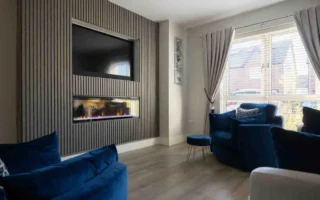Buying your first home is an exciting step in life. You’re probably focused on paint colors, furniture choices, and creating cozy corners that reflect your personality. That’s part of the joy—making your house feel like home. But amid all the décor decisions, many first-time homeowners overlook something essential: safety and structural soundness.
A beautiful home isn’t truly valuable unless it’s also secure, functional, and protected from preventable risks. Issues with your roof, electrical wiring, or plumbing might not show up immediately—but they can lead to costly repairs or safety hazards if left unaddressed.
This guide will help you look beyond aesthetics and walk you through key steps to ensure your first home stays safe, strong, and stress-free.
Secure the Roof: First Line of Defense
Your roof is one of the most critical elements of your home. It shields everything (and everyone) inside from rain, sun, wind, and snow. Yet, it’s easy to overlook, especially when there are no visible leaks. The problem is that roof issues often develop silently. Cracked shingles, soft spots, clogged gutters, or damaged flashing can let water seep in and cause mold, rot, and insulation damage.
Rather than inspecting it yourself, hire a professional roof inspection service. They know what to look for and how to spot hidden trouble areas. Many roof problems start small and get worse fast. Having regular inspections, especially after major storms, will help keep your home protected. Cleaning your gutters twice a year and trimming nearby trees will also help extend the roof’s life and keep it functioning well.
Fire Safety: More Than Just Smoke Alarms
Smoke detectors are essential, but they’re only one part of fire prevention. Every home should have working smoke alarms in every bedroom, hallway, and on each floor. These devices should be tested monthly, and the batteries need to be replaced at least once a year. But beyond that, you also need to take a close look at your electrical system.
Older homes, in particular, can have outdated wiring or overloaded circuits. If lights flicker, outlets feel warm, or breakers trip often, it’s time to bring in an electrician. Also, keep a fire extinguisher in the kitchen and check that everyone in your household knows where it is and how to use it.
Lock It Down
Your front door may have a solid lock, but what about the back door? Or that old basement window? Burglars tend to go for the weakest entry point, and sometimes, that’s not where you expect it. Reinforcing door frames, installing deadbolts, and upgrading to smart locks are all simple steps that improve security. Make sure your windows latch tightly, and consider adding sensors or shatter-resistant film to vulnerable ones. Also, think about outdoor lighting. Motion-activated lights near entry points can be a strong deterrent.
Don’t Ignore the Plumbing
A plumbing issue can cause major damage quickly if left unchecked. Even a small drip under a sink can lead to mold growth or water damage over time. That’s why it’s important to routinely check under cabinets, around toilets, and near appliances for signs of moisture. Learn where your main water shutoff valve is located and test it so you know it works when needed.
Slow drains or low water pressure might seem like small annoyances, but they can point to bigger issues like clogs or old pipes. If you’re unsure, bring in a licensed plumber for a full system check. Preventive action now can save you from expensive repairs later.
HVAC Health: Clean Air and Peace of Mind
Your heating, ventilation, and air conditioning (HVAC) system does more than just keep you comfortable. It also plays a key role in your home’s air quality. If neglected, your HVAC can spread dust, allergens, or even harmful mold spores.
Start with the basics: replace air filters regularly—every one to three months, depending on use and air quality. A clogged filter makes your system work harder, shortening its lifespan and raising energy bills. Schedule professional servicing at least once a year. A trained technician can clean internal components, check refrigerant levels, and make sure everything runs safely and efficiently.
Guard Against Moisture and Mold
Moisture is one of the most common and costly problems homeowners face. It can damage wood, warp walls, and lead to mold growth. Often, it starts in places you don’t see—behind walls, under floors, or in basements. That’s why it’s crucial to stay alert for early signs.
Peeling paint, persistent musty smells, or small patches of discoloration could point to hidden moisture. Kitchens, bathrooms, and laundry areas need proper ventilation. Use exhaust fans and open windows when possible.
Regularly inspect areas around sinks, tubs, and appliances like washing machines and dishwashers and fix leaks promptly. Mold doesn’t just hurt your home—it can harm your health.
Exterior Checks: What’s Outside Affects What’s Inside
The exterior of your home protects it against weather, pests, and wear. Walk around your property before the beginning of a new season. Look for cracks in the foundation, signs of erosion, or gaps where water or animals might get in.
Make sure your gutters are directing water away from your foundation. Poor drainage can lead to basement leaks and structural problems. Keep an eye on decks, fences, and railings too. Wood can rot over time, becoming unstable and unsafe.
Watch for signs of termite or rodent activity. Small holes, chewed wood, or droppings near entry points can signal a larger problem. Keeping your exterior sealed, clean, and in good repair goes a long way toward protecting your home’s interior.
Build Good Habits: Maintenance Calendar and Emergency Plans
Keeping your home safe isn’t about one big project—it’s about small actions done regularly. A home maintenance calendar helps you stay on track. Break tasks into seasonal checklists: cleaning gutters in spring and fall, servicing your HVAC before winter, checking fire extinguishers, testing alarms, and more.
Also, prepare for unexpected events. Know where your emergency shutoff valves are for water, gas, and electricity. Keep a list of emergency contacts and service providers.
Staying organized doesn’t take much time, but it makes a huge difference during emergencies or maintenance situations.
A secure and sound home doesn’t come from luck—it comes from paying attention and being proactive. From protecting your roof to maintaining clean air and building good safety habits, each step reinforces the value of your home. You don’t need to do everything at once, but you do need to make a start. When you take safety seriously, your home becomes more than just a place to live—it becomes a reliable, lasting investment that protects everything you care about.
You may aslo read (Little Fixes That Make a Big Difference in Home Living).




